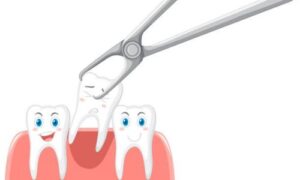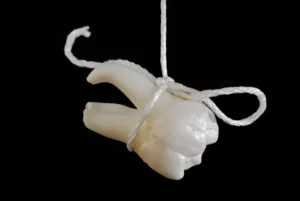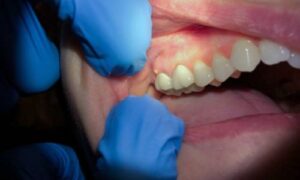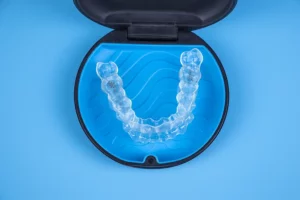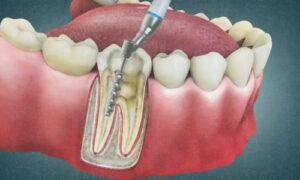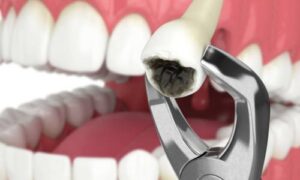Introduction:
Getting loose teeth out can be a memorable milestone for kids and sometimes adults. Knowing safe and easy methods can make the process smoother and less intimidating, whether it’s a wiggly baby tooth or a bothersome adult tooth. This article will explore some simple techniques for painlessly pulling out a loose tooth.
Understanding Loose Teeth:
Before diving into the methods, it’s essential to understand why teeth become loose. In children, loose teeth are a natural part of growing up. It signifies that their baby teeth are making way for permanent teeth to come in. However, loose teeth in adults can indicate gum disease, injury, or other dental issues. It’s crucial to differentiate between natural, wiggly teeth and those that require professional attention.
According to the American Academy of Pediatric Dentistry, most children lose their first baby teeth around age 6 and all 20 baby teeth by age 12.
Why Visit the Dentist for a Loose Tooth?
Dentists are the tooth experts! They can check if the tooth is ready to come out and ensure no underlying issues are causing the looseness. They can also remove the tooth smoothly, minimizing bleeding and discomfort.
Here’s why a dentist visit is important:
- Complete removal: Sometimes, a tooth root can break off and get stuck in the gum, leading to infection. A dentist can ensure the entire tooth is removed.
- Bleeding control: Dentists have the tools and expertise to manage any bleeding that might occur.
- Infection prevention: Proper removal reduces the risk of infection in the empty socket.
- Examining the replacement tooth: The dentist can check if the permanent tooth is developing properly underneath.
However, if you can’t see a dentist right away and the tooth is very loose and irritating, there are some safe ways to help it come out at home.
Easy Ways to Help a Loose Tooth Come Out (at Home)
Important Note: These methods should only be used for very loose teeth that are practically ready to fall out independently. If any pain or swelling, or the tooth feels firm, avoid these methods and see a dentist as soon as possible.
1. The Gentle Wiggle:
- Wash your hands thoroughly with soap and water.
- Gently wiggle the tooth back and forth with your clean fingers or tongue.
- Don’t force it – the tooth should move easily.
- Wiggling helps loosen the remaining gum tissue holding the tooth in place.
2. Crunchy Food Power:
- Bite down gently on a firm, but not hard, food like an apple, carrot, or celery stick.
- The natural chewing motion can help dislodge the loose tooth.
- Be careful not to bite down too hard and cause further loosening or damage to surrounding teeth.
3. Flossing Farewell:
- Use a clean piece of floss (around 18 inches long).
- Wrap the floss around each middle finger for better grip.
- Gently slide the floss between the loose tooth and its neighbor.
- Move the floss back and forth like sawing, then carefully pull upwards to remove the tooth.
- Only use this method if the tooth is loose and the floss can easily slide around it.
4. The Cold Compress Trick:
- Apply a cold compress (wrapped in a cloth) to the outside of your cheek near the loose tooth for a few minutes.
- The cold can help numb the area and reduce any discomfort during removal.
5. Warm Saltwater Rinse:
- Mix a teaspoon of salt in a warm glass of water.
- Swish thoroughly for 30 seconds, then spit.
- Rinsing with saltwater can help soothe the gums and promote healing after the tooth comes out.
Remember: These methods are for very loose teeth only. See a dentist immediately if you experience any pain, swelling, or bleeding.
After the Loose Teeth is Out:
- Gently bite down on a piece of gauze to control any bleeding.
- Rinse your mouth with warm saltwater several times a day for a few days to keep the area clean and prevent infection.
- Avoid hard or sticky foods that could irritate the empty socket.
- Expect some tenderness and swelling for a day or two, which is normal.
The Importance of Healthy Teeth
Loose teeth are a natural part of childhood, as baby teeth make way for permanent ones. However, good oral hygiene is crucial throughout life to keep your teeth healthy and strong. Here are some tips:
- Brush your teeth twice a day with fluoride toothpaste.
- Floss daily to remove plaque and food particles between teeth.
- Eat a healthy diet low in sugar and acidic foods.
- Schedule regular dental checkups and cleanings.
By taking care of your teeth, you can avoid loose teeth caused by gum disease or decay in the future.
Conclusion of Teeth Out
Pulling out a loose tooth doesn’t have to be a daunting experience. With these easy and safe methods, anyone can remove a loose tooth with minimal discomfort. There are plenty of options, whether waiting for it to fall out naturally, using dental floss, or trying the twist technique. And remember, when in doubt, it’s always best to consult a dentist for professional advice and guidance.
FAQs about Loose Teeth Out and Easy Removal Methods
Q: Is it okay to pull out a loose tooth myself?
A: Ideally, no. It’s safest to see a dentist to ensure complete removal and minimize infection risk. However, if the tooth is loose and irritating, and you can’t see a dentist immediately, the gentle methods in this article can help.
Q: How will I know if my child’s tooth is ready to come out?
A: The tooth will be wiggly and easily moved back and forth. Sometimes, children can feel the tooth getting loose before it starts wiggling. If your child is concerned about a loose tooth, a dentist can confirm if it’s ready.
Q: What are some signs I should see a dentist right away?
A: See a dentist if the loose tooth is causing significant pain, bleeding, or swelling. A dentist can also check for underlying issues, such as whether the tooth feels firm or doesn’t wiggle easily.
Q: Are there any risks to pulling out a loose tooth myself?
A: Yes. Pulling too early or forcefully can damage the gum tissue, nerves, or surrounding teeth. Additionally, if a tooth root breaks off and gets stuck, it can lead to infection.
Q: How long will the empty socket bleed after a loose tooth emerges?
A: Slight bleeding is normal for a short time (less than 10 minutes). If bleeding persists, gently bite down on a piece of gauze to apply pressure.



